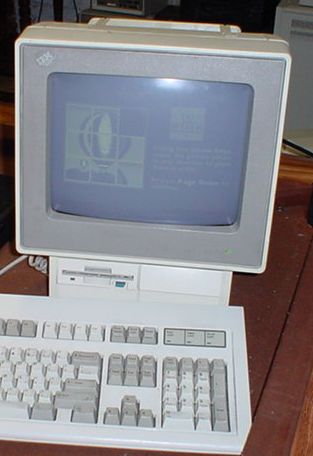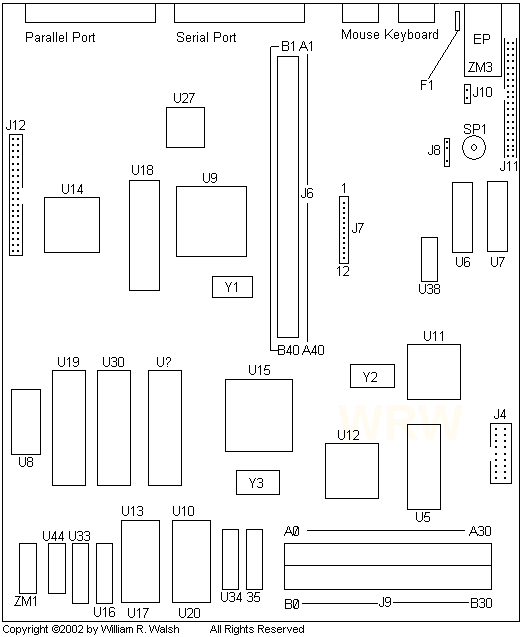PS/2 Model 25 (8525-001, 004) - 8086 CPU
Beware! This page has long been in a state of slumber (just like
pretty much everything else in the "computer collection" web pages). --
WW, November 2017

8525-001 has a monochrome ("paper white") display and an 8086 CPU.
The 8525-004 is the same computing hardware as the 8525-001, only it
features a color display. I've seen far more of these with color
displays than monochrome ones, so I'm guessing monochrome wasn't as
popular of a choice. That seems odd, given the number of standalone
PS/2 monochrome monitors I have.
Graphics Hardware
The 8086 variant of the Model 25 has MCGA graphics
hardware, wired to work with an analog VGA monitor. MCGA is a curious
mixture of different technologies: in addition to all modes supported
by a CGA adapter, it supports the low resolution (320x240) 256 color
VGA mode and high resolution (640x480) monochrome VGA. However, EGA
display modes are not supported.
All other PS/2 Models having a 286 microprocessor (or better) have VGA graphics hardware at a minimum.
Upgrades
I'm not aware of any for the CPU, short of replacing the
entire system board. As far as storage goes, something like an XT-IDE
board is probably your best bet. Older IDE and SCSI controllers have
their own expansion ROM on board may also work. A standard power
connector for a hard disk isn't available, though you can add one.
(Use the instructions for the 25SX/30-286/55SX ... the Model 25 8086
does NOT use the same power connector as the Model 30 8086!)
There are two internal expansion slots, both of which are 8-bit ISA types.
Memory expansion is limited to boards that provide additional RAM in compliance with the expanded memory specification (EMS).
Planar

Components:
Finally! The maker of U11 and U15 has been uncovered!
U? - Intel 8086-2 CPU at 8MHz
U5 - Inmos IMSG171P Video RAMDAC
U6 - Hitachi HM53461P
U7 - Hitachi HM53461P
U8 - Intel P8253-5
U9 - 72X8203
U10 - ROM BIOS (also marked U20, don't know why)
U11 - Seiko Epson (
 ) SLA64030J2L
) SLA64030J2LU13 - ROM BIOS, also marked as U17, no idea why
U14 - OKI/IBM 72X8206
U15 - Seiko Epson (
 ) SLA6330J1C
) SLA6330J1CU16 - NEC D4164C-10
U17 - See U13
U18 - NEC D765AC-2 (FDC?)
U19 - Siemens 8237A
U27 - National Semiconductor NS8250AV
U33 - NEC D4164C-10
U34 - NEC D4164C-10
U35 - NEC D4164C-10
U38 - Sony CXK5864BM-12L
U44 - OKI M3764A-15
ZM1 - OKI M3764A-15 (no mistake--it is not a "Uxx" marked chip!)
ZM3 - Earphone Connector (the "EP" above is not marked on the planar, I added it)
Y1 - 14.31818MHz OSC for software clock (this system has no CMOS hardware clock!)
Y2 - 25.175MHz OSC for what?
Y3 - 48.0MHz - divided by 6 for CPU clock?
F1 - Keyboard Fuse
(One of these days, I need to fix the colors in the Seiko Epson logo so that it's actually visible!)
Other stuff:
SP1 - Speaker
J4 - Display Connector
J7 - Power Connector
J8 - Four pin header, three pins present. Possible external speaker?
J9 A/B - 30 Pin SIMM Sockets
J10 - Two pin header for ?
J11 - IBM Hard Disk (totally proprietary, not IDE!)
J12 - Floppy Disk Connector (also proprietary, runs power over the data cable!)
I've been told that the 4xNEC D4164 are actually the 256KB upgrade that serve to give you a full 640KB of installed RAM. The SIMMs seemingly provide the base memory. (I'm not real sure I agree with that, since the SIMMs would be so much easier to install for an end user.)
Floppy Drive
Floppy drives are the bane of a PS/2 collector's existence. Pretty much all of them still in existence today will require repair before they are usable. At a minimum, you'll need to clean the dust and any foreign objects out of the drive. You might as well plan on replacing every one of the surface mounted electrolytic capacitors on the drive's circuit board, and almost certainly cleaning up the corrosive mess left behind.
Although IBM never sold them configured as such, the 8086 version of the PS/2 Model 25 has undocumented high density diskette drive (1.44MB) support. Not all disk drives will work: only the drives manufactured by Sony seem likely to work correctly. Other drives will only be "seen" as a low density type or may not work at all. The floppy drive controller is an NEC 765 or Intel 8272, both of which support high density diskettes, and the BIOS obviously has some support as well. Whichever planar you have in your Model 25 8086 also factors in -- later models are more flexible in regards to which diskette drives will actually work. (The same is true of the PS/2 Model 30.)
Back to Model 25 Page >
Copyright © 2002-2017 William R. Walsh. Some Rights Reserved. Last updated (this page only): November 19th, 2017.)